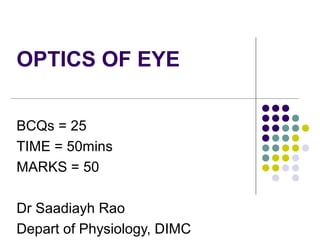
OPTICS OF EYE EXAM GUIDE
- 1. OPTICS OF EYE BCQs = 25 TIME = 50mins MARKS = 50 Dr Saadiayh Rao Depart of Physiology, DIMC
- 2. Light travels faster through: a. Air b. Liquids c. Solids d. Glass e. Water
- 3. Photo receptors are sensitive only to wavelengths b/w: a. 100-300nm b. 300-800nm c. 400-700nm d. 600-900nm e. 100-1000nm
- 4. Light with longest wavelength is: a. Violet b. Blue c. Red d. Green e. Yellow
- 5. Most of refraction occurs at: a. Ant surface of cornea b. Ant surface of lens c. Ant surface of retina d. Post surface of cornea e. Post surface of lens
- 6. Refractive ability of which of the following structure can be changed: a. Sclera b. Cornea c. Iris d. Lens e. Retina
- 7. The total refractive power of the reduced eye is: a. 80 b. 75 c. 69 d. 59 e. 49
- 8. Following statements are true about eye muscles EXCEPT: a. Medial rectus is supplied by abducent nerve b. Lateral rectus is supplied by abducent nerve c. Medial rectus is supplied by oculomotor nerve d. Superior oblique is supplied by trochlear nerve e. Inferior oblique causes elevation of eye
- 9. Sclera: a. Forms ant 1/3 of eyeball b. Is composed of dense connective tissues c. Is highly vascular layer d. Does not protect eyeball e. Is pierced by ciliary artery
- 10. Cornea: a. Is a semi transparent layer b. Forms ant 1/3 of eyeball c. Is highly vascular layer d. Is nourished by lymphatics e. Protect eye from light entry
- 11. In Astigmatism, the curvature of which of the following structure is uneven: a. Sclera b. Cornea c. Iris d. Lens e. Retina
- 12. Factor dilating pupil is: a. Near vision b. Emotions c. Sleep d. Exposure to Light e. Parasympathetic stimulation
- 13. Factor constricting pupil is: a. Distant vision b. Exposure to dark c. Emotions d. Sleep e. Sympathetic stimulation
- 14. Lens: a. Is a transparent biconcave elastic structure b. Lies b/w iris & vitreous body c. Aqueous humor fills the cavity behind it d. Is highly vascular structure e. Has more refractive ability than cornea
- 15. Cataract: a. An opaque area in eye lens b. Occurs due to defective lipids in lens c. Treated by topical medicines d. Occurs in old age only e. Is due to increased amount of aqueous humor
- 16. Most of the aqueous humor is secreted by: a. Cornea b. Lens c. Iris d. Choroid plexus e. Ciliary process
- 17. Aqueous humor is formed by the process of: a. Active secretion b. Osmosis c. Passive diffusion d. Facilitated diffusion e. Bulk transport
- 18. Aqueous humor contains all of the following EXCEPT: a. Water b. Sodium c. Fibrinogen d. Hyaluronic acid e. Ascorbic acid
- 19. Tonometry is a process of measuring: a. CSF pressure in ventricles b. CSF pressure in spinal cord c. Blood pressure in heart d. Pleural pressure e. Intraocular pressure
- 20. Retina: a. Is thin delicate outer layer of eyeball b. Extends posteriorly to ciliary body c. Is organized in three layers d. Rods & cones are present in neural portion e. Fovea is the region where optic nerve leave retina
- 21. Emmetropia: a. Is normal eye b. Occurs in old age c. Corrected by cylindrical lens d. Corrected by concave lens e. Corrected by convex lens
- 22. Presbyopia: a. Is more common in young age b. Occurs due to increase in range of accommodation c. Occurs in old age d. Treated by cylindrical lens e. Is normal eye
- 23. When the eye is accommodated for near vision: a. Ciliary muscles relax b. Pupil dilate c. Convergence of eyes d. Image of the object is focused in front of retina e. Image of the object is focused behind the retina
- 24. Stimulation of parasympathetic nerves to eye, causes: a. Relaxation of ciliary muscles b. Contraction of ciliary muscles c. Dilation of pupil d. Accommodation of eye for far vision e. Decrease in lens power
- 25. A myopic person: a. Needs bifocal lens b. Needs cylindrical lens c. Needs convex lens d. Is unable to see the far object clearly e. Is unable to see the near object clearly
- 26. The term hypermetropia means: a. Eyes with normal vision b. Difficulty in focusing near object c. Difficulty in focusing far object d. Failure of accommodation of eyes e. Increased intra ocular pressure
